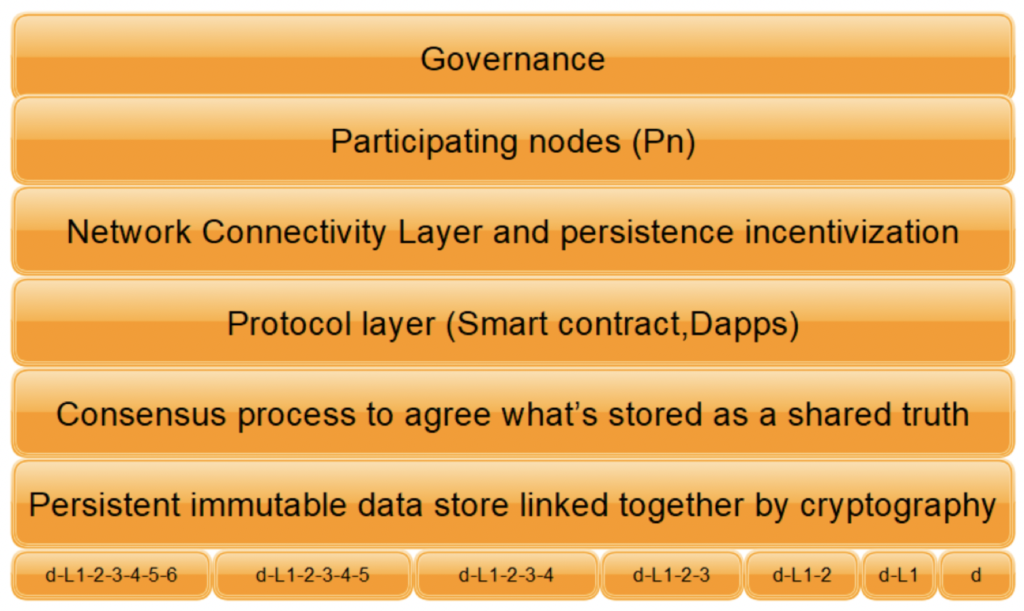
This is a guest post by Tony Vernall, a marine engineer turned Foreign Exchange trading and post-trade infrastructure engineer with a particular interest in Distributed Ledger Technology (DLT aka blockchain). Tony sees DLT becoming the future platform for financial trading due to the efficiencies and new business models that it will introduce.
I’ve heard the question “what is blockchain?” being asked many times and heard numerous different answers being given. One thing is for sure there are a lot of different interpretations and views of what blockchain is.
Considering the various innovative projects that seem to be turning up on a daily basis Distributed Ledger Technology (DLT aka blockchain ) is a set of ingredients that can be mixed in a variety of ways to give a trusted outcome.
The 6 essential ingredients tend to be:
- A Governance process.
- A set of Participating nodes (Virtual or physical machines that run the protocol).
- A Network connectivity layer with persistence incentivization.
- A Protocol layer (smart contract, Distributed applications (Dapps)).
- A Consensus process to agree what’s stored as a shared truth.
- A Persistent Immutable data store linked together by cryptography.
In diagrammatic format it would look like something like the below
Each of these layers is a thesis in its own right, don’t worry I’ll just give a brief description on each layer below.
Governance
Governance is who and how any changes to the protocol are agreed, how dispute resolution is managed, and how the platform is maintained and upgraded.
Participating nodes
A group of peers requiring to share information and trust what they see is what everyone else is seeing. One of the main differences between private and public DLTs at this level is that users on a public chain tend to be pseudonymous and those on a private DLT are know actors.
Network connectivity layer with persistence incentivization
How messages are passed from node to node, ie either using the gossip protocol were every node gets involved in the messaging or a more discreet point to point connectivity using a network map and a messaging Protocol (ie AMPQ). Persistence Incentivisation, the reason why someone would want to run a node such as coin rewards (public), or mutual cost savings(private).
Protocol layer (smart contract, Dapps)
The code that controls how the system acts and enables distributed code to operate. All public chains have open sourced code. Most Private chains are also open sourced for peer review but some keep their source code private and rely on their clients trusting any implementations done with non open sourced code.
Consensus process to agree what’s stored as a shared truth
An algorithm that brings a distributed system is to agreement. Public networks require more complex algorithms (that tend to slow transaction rates down) that can operate in a more hostile environment. Private chains in less hostile environments use faster methods and algorithms to come to consensus
Persistent Immutable data store linked together by cryptography
This is what is commonly referred to as the blockchain, shared immutable information that has a linked cryptographic provenance to its source. The main difference between private and public at this level is that in a public chain all the transactions of the network are put in a single block. This block is then added as the next link in the chain. Generally In Private ledgers only the parties that require to see the information maintain and store the linked cryptographic information.
So in summary it’s not any one thing but a combination of techniques that allow the governance of a trusted data structure which is agreed by consensus and linked together with cryptography.
Lets practically apply this model as a test on a few tasty DLTs (aka blockchians) and list their ingredients out.
| DLT /Ingredient | Bitcoin | Ethereum | Quorum | Hyperledger Fabric | Corda | Digital Asset | NEO | Qutum | IOTA | Hashgraph | Ripple | EOS |
|---|---|---|---|---|---|---|---|---|---|---|---|---|
| Governance | Open source & miners | Ethereum foundation & mining | Operator /privatley agreed | Open source / Hyperledger / privatley agreed | R3 consortium /privatley agreed | Digital Assets/privatley agreed | NEO team | Qtum Foundation | IOTA foundation | Hedera Hashgraph Council | Ripple | block.one and token participant voting |
| Nodes | Public | Public | Private | Private | Private | Private | public | Public | Public | Public | Private | Private |
| Network Type/ persistance | Gossip/Mining for coin reward incentivization (capped) | Gossip/Mining for coin reward incentivization | Gossip/constillation config, Mutual cost saving Platform | Gossip/channel config, Mutual cost saving Platform | Registery/Mutual cost saving Platform | Registery/Mutual cost saving Platform | Gossip/Coin reward incentivization | Gossip/Coin reward incentivization | User desire to use the technology | Gossip/coin reward incentivization | Registery/Mutual cost saving Platform | Utility Coin reward, No transaction fee for users |
| Protocol (SC,Dapps) | getblocktemplate | Solidity | Solidity | ChainCode GO | Java, Kotlin,Flows | DAML | NeoVM | Decentralized Governance Protocol (DGP) | smart contract Layer being developed | Solidity | interledger / codius | C++ |
| Concensus (Trans/sec) | Proof of work (7) | Proof of work (15) | Configrable,POS, RAFT BFT (100s) | Pluggable options (1000s) | Elected Notary (1000s), pluggable options | Delegated BFT (1000s) | Delegated BFT (10000s) | Proof of stake | DAG (100,000s) | DAG (100,000s) | Elected nodes (1000s) | delegated proof-of-stake (1,000,000) |
| Data Store | Ledger, stored by all nodes, No Privacey (UTXO) | Ledger, stored by all nodes, No Privacey | Ledger, channels can be set up or zk-SNARKs to ensure data privecy | Ledger (CouchDB), channels can be set up so data is only stored by the requied parties, Max privacey(UTXO) | Ledger, data only stored by requied parties, Max privacey (UTXO) | Ledger, data only stored by requied parties, Max privacey | Ledger, stored by all nodes, No Privacey | UTXO Ledger | Ledger,sharded | Ledger,sharded | Shared global ledger | Block producers |
| whats the ingrdients cook up | secure, slow, all data visable, value exchange | secure, slow,all data visable, trusted smart contracts environmnet | secure and private fast trusted smart contracts environmnet | secure and private, fast trusted smart contracts environmnet | secure and private, fast trusted smart contracts environmnet | secure and private, fast trusted smart contracts environmnet | Smart contract, Smart economy | hybrid of Ethereum and Bitcoin technology | Web3 & IOT machine to machine economy | Web3 & IOT | secure and private, fast trusted smart contracts environmnet | platform for the deployment of decentralized applications |
Hopefully the above description and table help in explaining what a blockchain might be: ) Any other views and feedback most welcome. If you’d like to get a copy of the spreadsheet with the dynamic links just email us info@insureblocks
Additionally if you’d like to become a guest blogger on Insureblocks please email us info@insureblocks





